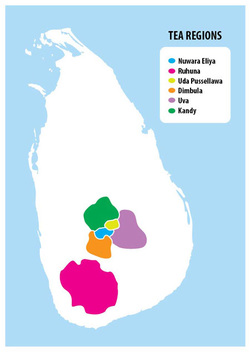Ceylon Tea - The pride of Sri Lanka
Tea came to be a principal crop in Sri Lanka in the early 1870’s. Prior to 1860s Sri Lanka’s main crop was coffee and no planter showed much interest in tea. A young Scottish man by the name of James Taylor who arrived in Ceylon in 1852 to work for one of the large coffee growers was mainly responsible for transformation of Ceylon’s plantation map from coffee to tea. Taylor was a scientific planter who was entirely devoted to his work. He was involved with Royal Botanical Gardens of peradeniya of Sri Lanka and it was there that he got his first tea seeds for experimental planting. The 19 area Loolecondera Estate where Taylor did the first commercial planting of tea became the model for future development of the tea industry in Sri Lanka.
Taylor made his home in Loolecondera and died 40 years later. James Toylor’s legacy is best summed up in the words of John Field, a former High Commissioner of Great Britain in Sri Lanka. He wrote ; “ It can be said of very few individuals that their labour have helped to shape the landscape of a country. The beauty of the hill country as it now appears owes much to inspiration of James Taylor, the man who introduced tea cultivation to Sri Lanka”
Taylor made his home in Loolecondera and died 40 years later. James Toylor’s legacy is best summed up in the words of John Field, a former High Commissioner of Great Britain in Sri Lanka. He wrote ; “ It can be said of very few individuals that their labour have helped to shape the landscape of a country. The beauty of the hill country as it now appears owes much to inspiration of James Taylor, the man who introduced tea cultivation to Sri Lanka”
Tea growing regions in Sri Lanka
KandyThe plantations around Kandy, which was once an ancient capital, supply what are known as mid-country teas. These are notable for full-bodied strong teas which appeal to everyone who likes a good country brew. The plantations are located from 2,000 to 4,000 feet and is the region where tea was first grown in Sri Lanka.
UvaGrown on the eastern slopes of Sri Lanka's central mountains, tea from the Uva district has quite a remarkable flavor and is widely used in many blends. Uva teas are known for their exotic aroma they present.
|
Nuwara EliyaNuwara Eliya teas are grown at an elevation of over 6000 feet. They have an exquisite flavor and aroma whilst the brew is comparatively light. It is delicious with a slice of lemon, lime or orange. It has been said that 'Nuwara Eliya is to Ceylon Tea. what champagne is to French wine'. Scenic and very beautiful to behold, gushing waterfalls, tea estates and green hills shrouded by mist is what one sees around Nuwara Eliya.
Uda PusselawaClimatic conditions are similar to that of Uva. Tea produced from these areas tend to have a medium body and a rosy taste. Leopards still roam among the mountain forest ranges of Uda Pussellawa.
|
DimbulaDimbula was one of the first areas to be planted after tea took over from coffee in the 1870's. The plantations, most of them around 5000 to 6000 feet up in the hills, produce a typical high grown tea, which is of the finest character and rich in colour throughout the year. A place of pilgrimage is Adam's Peak, a landmark of this area, sacred to many religions.
RuhunaGrown on the eastern slopes of Sri Lanka's central mountains, tea from the Uva district has quite a remarkable flavor and is widely used in many blends. Uva teas are known for their exotic aroma they present.
|


